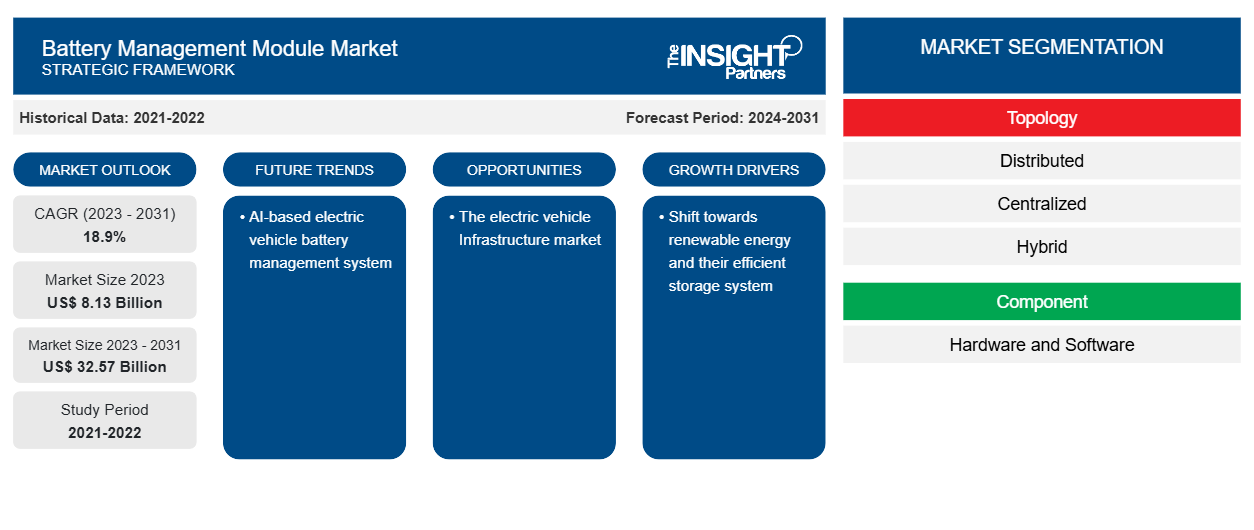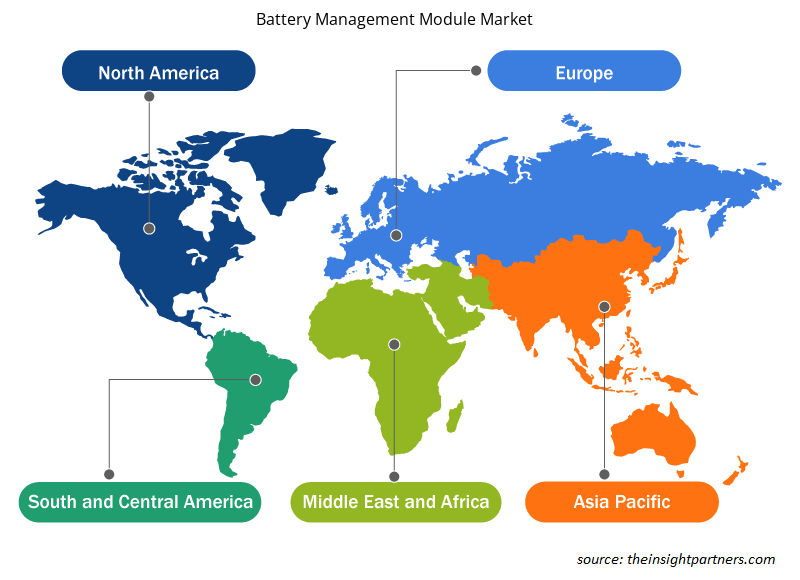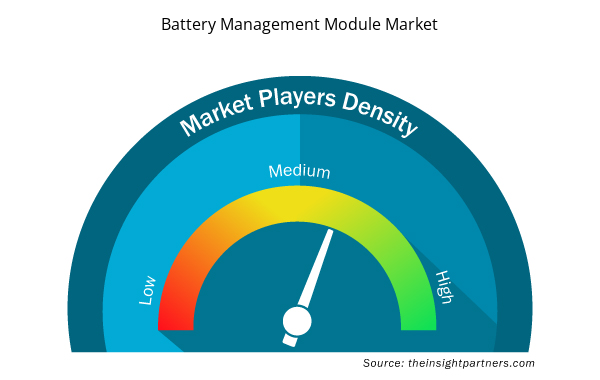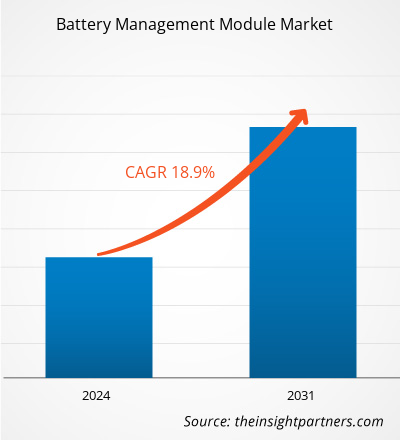The battery management module market size is projected to reach US$ 32.57 billion by 2031 from US$ 8.13 billion in 2023. The market is expected to register a CAGR of 18.9% in 2023–2031. The government's focus on cleaner transportation and the increase in the adoption of electric vehicles are likely to remain key to battery management module market trends.
Battery Management Module Market Analysis
A battery management module offers several advantages for a variety of applications, including energy storage systems, electric vehicles, and consumer electronics, which leads to its adoption. Some of the primary advantages of battery management modules include enhanced battery performance, efficiency, safety, remote monitoring and control, and an enhanced user experience, leading to its market growth. The mounting adoption of battery management modules in electric vehicles and the growing need for battery management in renewable energy systems are some of the crucial factors contributing to the battery management module market growth.
Battery Management Module Market Overview
Battery management modules or systems are electronic circuits that monitor and control battery charging and discharging. The battery characteristics that will be monitored include battery type, voltages, capacity, temperature, power consumption, state of charge, charging cycles, remaining operating time, and other characteristics. Battery management systems aim to make the optimal use of the residual energy in a battery. To avoid overloading the batteries, the battery management module protects them from deep discharge and over-voltage, which are caused by extremely fast charging and extremely high discharge currents. In the case of multi-cell batteries, the battery management system includes a cell balancing function to ensure that all battery cells have the same charging and discharging requirements.
Customize This Report To Suit Your Requirement
You will get customization on any report - free of charge - including parts of this report, or country-level analysis, Excel Data pack, as well as avail great offers and discounts for start-ups & universities
Battery Management Module Market: Strategic Insights

- Get Top Key Market Trends of this report.This FREE sample will include data analysis, ranging from market trends to estimates and forecasts.
Customize This Report To Suit Your Requirement
You will get customization on any report - free of charge - including parts of this report, or country-level analysis, Excel Data pack, as well as avail great offers and discounts for start-ups & universities
Battery Management Module Market: Strategic Insights

- Get Top Key Market Trends of this report.This FREE sample will include data analysis, ranging from market trends to estimates and forecasts.
Battery Management Module Market Drivers and Opportunities
Shift towards renewable energy and their efficient storage system to Favor Market
There is a rise in focus to cut carbon emissions and prevent the depletion of fossil fuels, leading to a shift in favor of renewable energy sources in recent times. Photovoltaic and wind energy are the spme of the most widely used renewable energy sources. These energies are widely available, but in terms of output and time, they are not steady and continuous sources. Storage solutions must be implemented in order to be able to supply the load at any time. Systems with battery energy storage are used to store electricity and balance the energy needed versus the energy that is available from the sources. They provide frequency and voltage control services in the event of sudden supply fluctuations. When there is a surplus of renewable energy, grid operators can save electricity using battery energy storage systems. The electricity can be stored in batteries and then distributed to cities, towns, homes, and factories when the demand is high.
The electric vehicle Infrastructure market
Various countries such as the US, India, UAE, and others are implementing various strategies to boost electric vehicle sales that will bolster their market in the coming years and further contribute to a cleaner environment. The government's focus on the production of electric vehicles generates the requirement for its charging infrastructure, where the demand for battery management modules gains traction. For example, according to The White House, in December 2023, the US President’s modern American industrial strategy focused on building a clean energy economy. Their goal of net zero emissions by 2050 requires large-scale adoption of electric vehicles (EVs). The President invested US$ 7.5 billion from his Bipartisan Infrastructure Law towards building a national network of EV chargers.
Battery Management Module Market Report Segmentation Analysis
Key segments that contributed to the derivation of the battery management module market analysis are topology, component, and end-user.
- By topology, the market is segmented into distributed, centralized, and hybrid. The centralized segment is expected to grow with the highest CAGR.
- Based on the component, the market is segmented into hardware and software. The hardware segment held the largest market share in 2023.
- By end-user, the market is segmented into automotive, medical, energy & power, consumer electronics, IT & telecom, and others. The automotive segment is expected to grow with the highest CAGR.
Battery Management Module Market Share Analysis by Geography
The geographic scope of the battery management module market report is mainly divided into five regions: North America, Asia Pacific, Europe, Middle East & Africa, and South America/South & Central America.
Asia Pacific region is expected to grow with the highest CAGR. With the rise in the electric vehicle market in the region, the demand for robust charging infrastructure generates the need for battery management modules. The need for efficient battery monitoring in the renewable energy sector futher drives the battery management module market growth in the region.
Battery Management Module Market Regional Insights
Battery Management Module Market Regional Insights
The regional trends and factors influencing the Battery Management Module Market throughout the forecast period have been thoroughly explained by the analysts at Insight Partners. This section also discusses Battery Management Module Market segments and geography across North America, Europe, Asia Pacific, Middle East and Africa, and South and Central America.

- Get the Regional Specific Data for Battery Management Module Market
Battery Management Module Market Report Scope
| Report Attribute | Details |
|---|---|
| Market size in 2023 | US$ 8.13 Billion |
| Market Size by 2031 | US$ 32.57 Billion |
| Global CAGR (2023 - 2031) | 18.9% |
| Historical Data | 2021-2022 |
| Forecast period | 2024-2031 |
| Segments Covered |
By Topology
|
| Regions and Countries Covered | North America
|
| Market leaders and key company profiles |
Battery Management Module Market Players Density: Understanding Its Impact on Business Dynamics
The Battery Management Module Market market is growing rapidly, driven by increasing end-user demand due to factors such as evolving consumer preferences, technological advancements, and greater awareness of the product's benefits. As demand rises, businesses are expanding their offerings, innovating to meet consumer needs, and capitalizing on emerging trends, which further fuels market growth.
Market players density refers to the distribution of firms or companies operating within a particular market or industry. It indicates how many competitors (market players) are present in a given market space relative to its size or total market value.
Major Companies operating in the Battery Management Module Market are:
- NXP Semiconductors N.V.
- Analog Devices, Inc.
- Johnson Matthey
- Texas Incorporated
- Renesas Electronics Corporation
- Nuvation
Disclaimer: The companies listed above are not ranked in any particular order.

- Get the Battery Management Module Market top key players overview
Battery Management Module Market News and Recent Developments
The Battery Management Module Marketis evaluated by gathering qualitative and quantitative data post primary and secondary research, which includes important corporate publications, association data, and databases. The following is a list of developments in the market:
- In May 2023, Sensata Technologies launched a c-BMS24X battery management system with advanced software features for industrial applications and low-voltage electric vehicles. The c-BMS24X uses advanced software functionality that enables improvements in vehicle range, uptime, battery health, and performance in applications up to 24 cells in series and 2000 amps like energy storage systems (ESS), scooters, 3-wheelers, forklifts, and AGVs. (Source: Sensata Technologies, Press Release, 2023)
- In May 2022, Marelli, a leading global automotive supplier, expanded its range of battery management technologies for electric vehicles with a new state-of-the-art wireless distributed battery management system (wBMS). This technology eliminates the wired physical connections typically needed in other battery management system (BMS) architectures, allowing for greater flexibility, increased efficiency, improved reliability, and reduced costs, all crucial aspects of electric vehicles. (Source: Marelli, Press Release, 2022)
- In May 2023, NUVATION ENERGY released a 1500-volt battery management system for stationary energy storage. The G5 BMS has been optimized to meet the needs of an ever-evolving battery energy storage industry. Significant updates include support for 1500 Volt power conversion systems, which can drive down the cost of storage by enabling more energy to be included in each energy storage system. It also includes system integration optimizations, such as a smaller hardware footprint per battery stack and updates to Nuvation’s patented battery management algorithms. (Source: NUVATION ENERGY, Press Release, 2023)
Battery Management Module Market Report Coverage and Deliverables
The “Battery Management Module Market Size and Forecast (2021–2031)” report provides a detailed analysis of the market covering below areas:
- Market size and forecast at global, regional, and country levels for all the key market segments covered under the scope
- Market dynamics such as drivers, restraints, and key opportunities
- Key future trends
- Detailed PEST/Porter’s Five Forces and SWOT analysis
- Global and regional market analysis covering key market trends, major players, regulations, and recent market developments
- Industry landscape and competition analysis covering market concentration, heat map analysis, prominent players, and recent developments
- Detailed company profiles
- Historical Analysis (2 Years), Base Year, Forecast (7 Years) with CAGR
- PEST and SWOT Analysis
- Market Size Value / Volume - Global, Regional, Country
- Industry and Competitive Landscape
- Excel Dataset


- Europe Surety Market
- Electronic Signature Software Market
- Quantitative Structure-Activity Relationship (QSAR) Market
- Fishing Equipment Market
- USB Device Market
- Mail Order Pharmacy Market
- Health Economics and Outcome Research (HEOR) Services Market
- Artwork Management Software Market
- Wheat Protein Market
- Organoids Market

Report Coverage
Revenue forecast, Company Analysis, Industry landscape, Growth factors, and Trends

Segment Covered
Topology, Component, End-User, and Geography

Regional Scope
North America, Europe, Asia Pacific, Middle East & Africa, South & Central America

Country Scope
Argentina, Australia, Brazil, Canada, China, France, Germany, India, Italy, Japan, Mexico, Russian Federation, Saudi Arabia, South Africa, South Korea, United Arab Emirates, United Kingdom, United States
Frequently Asked Questions
The global battery management module market was estimated to be US$ 8.13 billion in 2023 and is expected to grow at a CAGR of 18.9% during the forecast period 2023 - 2031.
The government's focus on cleaner transportation and the increase in the adoption of electric vehicles are the major factors that propel the global battery management module market.
AI-based electric vehicle battery management system is anticipated to play a significant role in the global battery management module market in the coming years.
The key players holding majority shares in the global battery management module market are NXP Semiconductors N.V.; Analog Devices, Inc.; Johnson Matthey; Texas Incorporated, Renesas Electronics Corporation; and Nuvation.
The global battery management module market is expected to reach US$ 32.57 billion by 2031.
The incremental growth expected to be recorded for the global battery management module market during the forecast period is US$ 24.44 billion.

 Get Free Sample For
Get Free Sample For